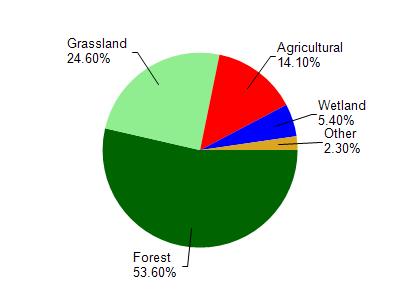Iowa
No
No
No
Fish and Aquatic Life
Overview
Taliesin Lake
, in the Otter and Morrey Creeks Watershed, is a 16.70 acre lake that falls in Iowa County. This lake is managed for fishing and swimming and is currently not considered impaired.
Date 2015
Author Aquatic Biologist
Historical Description
Source: 1968, Surface Water Resources of Iowa County,WI: WI-DNR Lower Taliesen Lake, T8N, R4E, Section 30- 8 Surface Acres = 9.9, S.D.F. = 1.8, Maximum depth = 10.5 feet Lower Taliesen Lake is one of the two small impoundments on the lower part of Lowery Creek (Van Blarcum). It is located on the estate of the late Frank Lloyd Wright. The dam at the outlet maintains a head of 14 feet. All of the land which surrounds it is part of the estate and is private with no public access. Little is known of its fishery but its shallow depth suggests that it probably contains a limited bass-panfish fishery with a complement of forage fishes usually found in the stream above. There is a marshy fringe on part of its shoreline which serves as encouragement for muskrats which are common. Waterfowl consisting of mallards, blue-winged teal and wood ducks are found consistently on the open water. Access is limited to a road crossing the feeder stream. The modesty of the resource suggests that no further access is needed. Source: 1968, Surface Water Resources of Iowa County,WI: WI-DNR Upper Taliesen, T8N, R4E, Section 30 Surface Acres = 9.4, S.D.F. = 2.4, Maximum Depth = 5 feet Upper Taliesen Lake is an impoundment on the lower part of Lowery Creek (Van Blarcum) and is located immediately above Lower Taliesen Lake on the estate of the late Frank Lloyd Wright. It is completely surrounded by private lands and there are several acres of shallow marsh on is upper end. The fishery is similar to that of the incoming stream but trout are probably scarce. Panfish such as bluegills and bullheads are probably present with the possibility of largemouth bass and northern pike. A weed problem as a result of its being quite shallow are limiting factors for good fish production.
Date 1968
Author Surface Water Inventory Of Wisconsin
Condition
Wisconsin has over 84,000 miles of streams, 15,000 lakes and milllions of acres of wetlands. Assessing the condition of this vast amount of water is challenging. The state's water monitoring program uses a media-based, cross-program approach to analyze water condition. An updated monitoring strategy (2015-2020) is now available. Compliance with Clean Water Act fishable, swimmable standards are located in the Executive Summary of Water Condition in 2018. See also the 'monitoring and projects' tab.
Reports
Management Goals
Wisconsin's Water Quality Standards provide qualitative and quantitative goals for waters that are protective of Fishable, Swimmable conditions [Learn more]. Waters that do not meet water quality standards are considered impaired and restoration actions are planned and carried out until the water is once again fishable and swimmable
Management goals can include creation or implementation of a Total Maximum Daily Load analysis, a Nine Key Element Plan, or other restoration work, education and outreach and more. If specific recommendations exist for this water, they will be displayed below online.
Monitoring
Monitoring the condition of a river, stream, or lake includes gathering physical, chemical, biological, and habitat data. Comprehensive studies often gather all these parameters in great detail, while lighter assessment events will involve sampling physical, chemical and biological data such as macroinvertebrates. Aquatic macroinvertebrates and fish communities integrate watershed or catchment condition, providing great insight into overall ecosystem health. Chemical and habitat parameters tell researchers more about human induced problems including contaminated runoff, point source dischargers, or habitat issues that foster or limit the potential of aquatic communities to thrive in a given area. Wisconsin's Water Monitoring Strategy was recenty updated.
Grants and Management Projects
| Project Name (Click for Details) | Year Started |
|---|
|
|
Monitoring Projects
| WBIC | Official Waterbody Name | Station ID | Station Name | Earliest Fieldwork Date | Latest Fieldwork Date | View Station | View Data |
|---|
| 1241700 | Unnamed | 10050691 | Unnamed (1241700) at STH 23 | 6/28/2018 | 10/14/2025 | Map | Data |
| 1241600 | Taliesin Lake | 10002727 | Taliesin Lake | 7/27/1999 | 10/3/2012 | Map | Data |
|

Watershed Characteristics
Taliesin Lake is located in the Otter and Morrey Creeks watershed which is 198.69 mi². Land use in the watershed is primarily forest (53.60%), grassland (24.60%) and a mix of agricultural (14.10%) and other uses (7.70%). This watershed has 437.57 stream miles, 351.55 lake acres and 5,785.74 wetland acres.
Nonpoint Source Characteristics
This watershed is ranked Not Ranked for runoff impacts on streams, Low for runoff impacts on lakes and High for runoff impacts on groundwater and therefore has an overall rank of High. This value can be used in ranking the watershed or individual waterbodies for grant funding under state and county programs.However, all waters are affected by diffuse pollutant sources regardless of initial water quality. Applications for specific runoff projects under state or county grant programs may be pursued. For more information, go to surface water program grants.